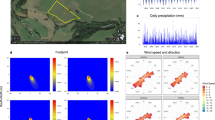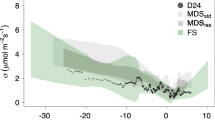Abstract
Accurate eddy covariance (EC) measurements require that the atmospheric and orographic conditions meet certain criteria. It is common that up to 60% of the original data must be rejected. In particular, a high percentage of data is often removed during nocturnal periods. Currently, the most widely used method for filling gaps in EC datasets is the tool developed at the Max Planck Institute for Biogeochemistry [as reported by Falge et al. (2001), Reichstein et al. (2005), and Wutzler et al. (2018)]. This tool has been primarily developed and tested for the gap-filling of CO2 fluxes. In this study, we provide the first detailed testing of this gap-filling tool on LE fluxes and explore alternative settings in the gap-filling procedure using different meteorological drivers. The tests were conducted using five EC data sets. Random artificial gaps of four different gap-length scenarios were used to compare the settings. Error propagation for both the default and alternative settings was computed for various time aggregations. In general, we confirm a good performance of the standard gap-filling tool with a bias error of − 0.09 and − 0.21 W m−2 for nocturnal growing and non-growing season cases, respectively, while daytime average bias error was 0.01 W m−2. Alternative settings produced similar results to the default settings for diurnal cases; however, the alternative settings substantially (81%) improved the performance of night-time gap-filling. At sites where night-time LE fluxes are significant, we recommend using net radiation instead of global radiation and relative air humidity instead of vapour pressure deficit to drive the LE gap-filling.





Similar content being viewed by others
References
Alavi N, Warland JS, Berg AA (2006) Filling gaps in evapotranspiration measurements for water budget studies: evaluation of a Kalman filtering approach. Agric For Meteorol 141(1):57–66
Allen RG, Pruitt WO, Wright JL, Howell TA, Ventura F, Snyder R, Itenfisu D, Steduto P, Berengena J, Yrisarry JB, Smith M, Pereira LS, Raes D, Perrier A, Alves I, Walter I, Elliott R (2006) A recommendation on standardized surface resistance for hourly calculation of reference ETo by the FAO56 penman-Monteith method. Agric Water Manag 81:1–22
Aubinet M, Vesala T, Papale D (2012) Eddy covariance: a practical guide to measurement and data analysis. Springer, Dodrecht, 438 pp
Burba GG, Mcdermitt DK, Anderson DJ, Furtaw MD, Eckles RD (2010) Novel design of an enclosed CO2/H2O gas analyser for eddy covariance flux measurements. Tellus 62B:743–748
Cava D, Giostra U, Siqueira M, Katul G (2004) Organised motion and radiative perturbations in the nocturnal canopy sublayer above an even-aged pine Forest. Bound-Layer Meteorol 112(1):129–157
Chen YY, Chu CR, Li MH (2012) A gap-filling model for eddy covariance latent heat flux: estimating evapotranspiration of a subtropical seasonal evergreen broad-leaved forest as an example. J Hydrol 468:101–110
Dušek J, Hudecová Š, Stellner S (2017) Extreme precipitation and long-term precipitation changes in a Central European sedge-grass marsh in the context of flood occurrence. Hydrol Sci J 62(11):1796–1808
Eichinger WE, Parlange MB, Stricker H (1996) On the concept of equilibrium evaporation and the value of the Priestley-Taylor coefficient. Water Resour Res 32:161–164
Falge E, Baldocchi D, Olson R, Anthoni P, Aubinet M, Bernhofer C, Burba G, Ceulemans G, Clement R, Dolman H, Granier A, Gross P, Grunwald T, Hollinger D, Jensen NO, Katul G, Keronen P, Kowalski A, Lai CT, Law BE, Meyers T, Moncrieff J, Moors E, Munger JW, Pilegaard K, Rannik U, Rebmann C, Suyker A, Tenhunen J, Tu K, Verma S, Vesala T, Wilson K, Wofsy S (2001) Gap filling strategies for long term energy flux data sets. Agric For Meteorol 107(1):71–77
Foken T (2008) Micrometeorology. Springer-Verlag, Berlin Heidelberg, Berlin 308pp
Göckede M, Rebmann C, Foken T (2004) A combination of quality assessment tools for eddy covariance measurements with footprint modelling for the characterisation of complex sites. Agric For Meteorol 127(3–4):175–188
Grünwald T, Bernhofer T (2007) A decade of carbon, water and energy flux measurements of an old spruce forest at the Anchor Station Tharandt. Tellus 59B:387–396
Hui DF, Wan SQ, Su B, Katul G, Monson R, Luo YQ (2004) Gap-filling missing data in eddy covariance measurements using multiple imputation (MI) for annual estimations. Agric For Meteorol 121(1–2):93–111
Iritz Z, Lindroth A (1994) Night-time evaporation from a short-rotation willow stand. J Hydrol 157:235–245
Kang M, Kim J, Malla Thakuri B, Chun J, Cho C (2018) New gap-filling and partitioning technique for H2O eddy fluxes measured over forests. Biogeosciences 15:631–647
Krupková L, Marková I, Havránková K, Pokorný R, Urban O, Šigut L, Pavelka M, Cienciala E, Marek MV (2017) Comparison of different approaches of radiation use efficiency of biomass formation estimation in mountain Norway spruce. Trees 31:325–337
Krupková L, Havránková K, Krejza J, Sedlák P, Marek MV (2018) Impact of drought on gross primary productivity of spruce and beech forests. J For Res Published online 30:899–909. https://doi.org/10.1007/s11676-018-0642-5
Larcher W (2003) Physiological plant ecology: ecophysiology and stress physiology of funcional groups. Springer, Berlin, 513 pp
Liu SM, Xu ZW, Wang WZ, Jia ZZ, Zhu MJ, Bai J, Wang JM (2011) A comparison of eddy-covariance and large aperture scintillometer measurements with respect to the energy balance closure problem. Hydrol Earth Syst Sci 15(4):1291–1306
Mauder M, Foken T (2006) Impact of post-field data processing on eddy covariance flux estimates and energy balance closure. Meteorol Z 15(6):597–609
Mauder M, Cuntz M, Drue C, Graf A, Rebmann C, Schmid HP, Schmidt M, Steinbrecher R (2013) A strategy for quality and uncertainty assessment of long-term eddy-covariance measurements. Agric For Meteorol 169:122–135
McGloin RP, Mcgowan HA, Mcjannet D (2015) Effects of diurnal, Intraseasonal and seasonal climate variability on the energy balance of a small subtropical reservoir. Int J Climatol 35:2308–2325
Moderow U, Aubinet M, Feigenwinter C, Kolle O, Lindroth A, Mölder M, Montagnani L, Rebmann C, Bernhofer C (2009) Available energy and energy balance closure at four coniferous forest sites across Europe. Theor Appl Climatol 98:397–412
Moffat AM, Papale D, Reichstein M, Hollinger DY, Richardson AD, Barr AG, Beckstein C, Braswell BH, Churkina G, Desai AR, Falge E, Gove JH, Heimann M, Hui DF, Jarvis AJ, Kattge J, Noormets A, Stauch VJ (2007) Comprehensive comparison of gap-filling techniques for eddy covariance net carbon fluxes. Agric For Meteorol 147(3–4):209–232
Monteith JL, Unsworth MH (1990) Principles of environmental physics. Academic Press, Oxford, 422 pp
Novick KA, Oren R, Stoy PC, Siqueira MBS, Katul GG (2009) Nocturnal evapotranspiration in eddy-covariance records from three co-located ecosystems in the southeastern US: implications for annual fluxes. Agric For Meteorol 149(9):1491–1504
Osihi C, Oren R, Stoy PC (2008) Estimating components of forest evapotranspiration: a footprint approach for scaling sap flux measurements. Agric For Meteorol 148:1719–1732
Park J, Byun K, Choi M, Jang E, Lee J, Lee Y, Jung S (2015) Evaluation of statistical gap fillings for continuous energy flux (evapotranspiration) measurements for two different land cover types. Stoch Env Res Risk A 29(8):2021–2035
R Core Team (2017) R: A language and environment for statistical computing. R Foundation for Statistical Computing, Vienna, Austria. Availeble via DIALOG. https://www.R-project.org/
Rebmann C, Gockede M, Foken T, Aubinet M, Aurela M, Berbigier P, Bernhofer C, Buchmann N, Carrara A, Cescatti A, Ceulemans R, Clement R, Elbers JA, Granier A, Grunwald T, Guyon D, Havrankova K, Heinesch B, Knohl A, Laurila T, Longdoz B, Marcolla B, Markkanen T, Miglietta F, Moncrieff J, Montagnani L, Moors E, Nardino M, Ourcival JM, Rambal S, Rannik U, Rotenberg E, Sedlak P, Unterhuber G, Vesala T, Yakir D (2005) Quality analysis applied on eddy covariance measurements at complex forest sites using footprint modelling. Theor Appl Climatol 80(2–4):121–141
Reichstein M, Falge E, Baldocchi D, Papale D, Aubinet M, Berbigier P, Bernhofer C, Buchmann N, Gilmanov T, Granier A, Grunwald T, Havrankova K, Ilvesniemi H, Janous D, Knohl A, Laurila T, Lohila A, Loustau D, Matteucci G, Meyers T, Miglietta F, Ourcival JM, Pumpanen J, Rambal S, Rotenberg E, Sanz M, Tenhunen J, Seufert G, Vaccari F, Vesala T, Yakir D, Valentini R (2005) On the separation of net ecosystem exchange into assimilation and ecosystem respiration: review and improved algorithm. Glob Chang Biol 11(9):1424–1439
Reichstein M, Moffat AM, Wutzler T, Sickel K (2017) REddyProc: data processing and plotting utilities of (half-)hourly eddy-covariance measurements. R package version 1.0.0/r18. Availeble via DIALOG. https://R-Forge.R-project.org/projects/reddyproc/
Stull RB (2009) An introduction to boundary layer meteorology. Repr. publ. Springer, New York
Wutzler T, Lucas-Moffat A, Migliavacca M, Knauer J, Sickel K, Sigut L, Menzer O, Reichstein M (2018) Basic and extensible post-processing of eddy covariance flux data with REddyProc. Biogeosciences 15:5015–5030
Funding
This work was supported by the Ministry of Education, Youth and Sports of CR within the SustEs program, grant number CZ.02.1.01/0.0/0.0/16_019/0000797, and within the CzeCOS program, grant number LM2015061. This work was done with support of Cost PROFOUND action FP1304. This work was done with support of Integrated Project CarboEurope-IP Assessment of the European Terrestrial Carbon Balance and Integrated Carbon Observation System (ICOS). This work was supported by Academy of Finland project 281255.
Author information
Authors and Affiliations
Corresponding author
Additional information
Publisher’s note
Springer Nature remains neutral with regard to jurisdictional claims in published maps and institutional affiliations.
Electronic supplementary material
ESM 1
(DOC 40.2 mb)
Rights and permissions
About this article
Cite this article
Foltýnová, L., Fischer, M. & McGloin, R.P. Recommendations for gap-filling eddy covariance latent heat flux measurements using marginal distribution sampling. Theor Appl Climatol 139, 677–688 (2020). https://doi.org/10.1007/s00704-019-02975-w
Received:
Accepted:
Published:
Issue Date:
DOI: https://doi.org/10.1007/s00704-019-02975-w




